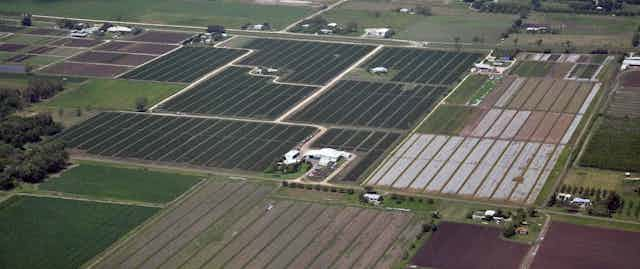Cyclone Debbie, which lashed the Queensland coast a week ago, has hit farmers hard in the area around Bowen – a crucial supplier of vegetables to Sydney, Melbourne and much of eastern Australia.
With the Queensland Farmers’ Federation estimating the damage at more than A$100 million and winter crop losses at 20%, the event looks set to affect the cost and availability of fresh food for millions of Australians. Growers are reportedly forecasting a price spike in May, when the damaged crops were scheduled to have arrived on shelves.
The incident also raises broader questions about the resilience of Australia’s fresh vegetable supply, much of which comes from a relatively small number of areas that are under pressure from climate and land use change.
In 2011 the Bowen area produced 33% of Australia’s fresh beans, 46% of capsicum and 23% of fresh tomatoes, making it the country’s largest producer of beans and capsicums, and number two in fresh tomatoes.
The region also produces a significant amount of chillies, corn, cucumbers, eggplant, pumpkin, zucchini and squash, and is a key production area for mangoes and melons.
Coastal Queensland’s vegetable regions are among the highest-producing in the country, especially for perishable vegetables. The Whitsunday region around Bowen, and the area around Bundaberg further south are each responsible for around 13% of the national perishable vegetable supply.
As the chart below shows, vegetable production is highly concentrated in particular regions, typically on the fringes of large cities. These “peri-urban” regions, when added to the two major growing areas in coastal Queensland, account for about 75% of Australia’s perishable vegetables.

Australia’s climate variability means that most fresh produce can be grown domestically. The seasonable variability allows production to move from the south to the north in the winter, when the Bundaberg and Bowen areas produce most of the winter vegetables consumed in Brisbane, Sydney and Melbourne. The Bowen Gumlu Growers Association estimates that during the spring growing season in September—October, the region produces 90% of Australia’s fresh tomatoes and 95% of capsicums.
Besides damaging crops, Cyclone Debbie has also destroyed many growers’ packing and cool storage sheds. The cost of rebuilding this infrastructure may be too much for many farmers, and the waterlogged soils are also set to make planting the next crop more difficult.
The recovery of production in these areas is crucial for the supply. Growers who have lost their May crop will first have to wait until the paddocks dry out, then source new seedlings and plant them. It could be weeks until crops can be replanted, and storage and processing facilities replaced.
The Queensland government has announced natural disaster relief funding, including concessional loans of up to A$250,000 and essential working capital loans of up to A$100,000, to help farmers replant and rebuild.
Meanwhile, consumers of fresh vegetables in Sydney and Melbourne and many other places are likely to find themselves paying more until the shortfall can be replaced.
Fresh food for growing cities
Australia’s cities are growing rapidly, along with those of many other countries. The United Nations has predicted that by 2050 about 87% of the world’s population will live in cities. This urban expansion is putting ever more pressure on peri-urban food bowls.
Food production is also under pressure from climate change, raising the risk of future food shocks and price spikes in the wake of disasters such as cyclones. Meanwhile, the desire for semi-rural lifestyles is also conflicting with the use of land for farming (see Sydney’s Food Futures and Foodprint Melbourne for more).
These pressures mean that Australia’s cities need to make their food systems more resilient, so that they can withstand food shocks more easily, and recover more quickly.
Key features of a resilient food system are likely to include:
geographic diversity in production, which spreads the risk of crop damage from extreme weather events across a number of different production areas;
more local food production, to reduce transportation and storage costs and avoid over-reliance on particular regions;
a diverse, healthy and innovative farming community;
greater consumer awareness of the importance of seasonal and locally produced food;
recycling of urban waste and water for use on farms, to reduce the use of fresh water and fertilisers;
the capacity to import food from overseas to meet shortfalls in domestic supply;
increased use of protected cropping systems such as greenhouses, which are better able to withstand adverse weather.
Two recent studies of food production around Sydney and Melbourne provide examples of a range of mechanisms and policies for increasing the resilience of the food systems of Australian cities.
Our food system has served us well until now, but land use pressures and climate change will make it harder in future. When a cyclone can knock out a major production region overnight, with knock-on effects for Australian consumers, this points to a lack of resilience in Australia’s fresh vegetable supply.

